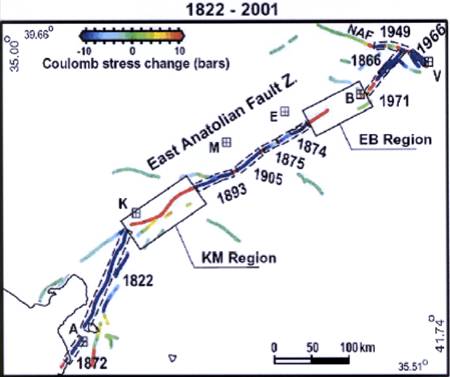| 2003 |

|
YEAR BOOK |
University of Ulster
|
Where will the next earthquake occur?
|

An example of this for the East Anatolian Fault in Turkey is illustrated. This 580 km long fault undergoes approximately 9 mm of left lateral displacement (in other words, the other side of the fault moves to the left) each year and has a history of large (magnitude greater than 6.5) events. In order to compute the current state of stress, we need to know the length of each previous rupture as well as its distribution of slip. Not surprisingly, this information is readily available for recent, well-instrumented earthquakes but is much more difficult to estimate for earlier events.
Our best estimate of the current stress state of the East Anatolian Fault is shown in the illustration. The dashed boxes show the scars of historical earthquakes between 1822 and 1971 as well as the stress on the fault. Red areas are highly stressed and are therefore most at risk. The boxed area labelled 'KM region' is of particular concern as it is highly populated and is believed to have experienced large earthquakes in the past. Based on this work, Turkish scientists are currently conducting field studies to further assess the seismic risk in the area.
Contact: More information about the Geophysics Research Group and its work on earthquake physics, fluid flow in fractured porous media, and aeolian sediment transport can be found at http://www.science.ulst.ac.uk/crg/geophys/index.html or by emailing Dr Sandy Steacy at [email protected]